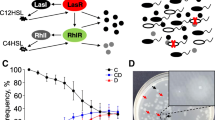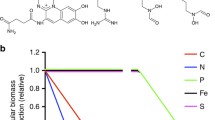Abstract
In the bacterium Pseudomonas aeruginosa, the synthesis and secretion of extracellular protease is a typical cooperative behavior regulated by quorum sensing. However, this type of cooperative behavior is easily exploited by other individuals who do not synthesize public goods, which is known as the “tragedy of the commons”. Here P. aeruginosa was inoculated into casein media with different nitrogen salts added. In casein broth, protease (a type of public good) is necessary for bacterial growth. After 30 days of sequential transfer, some groups propagated stably and avoided “tragedy of the commons”. The evolved cooperators who continued to synthesize protease were isolated from these stable groups. By comparing the characteristics of quorum sensing in these cooperators, an identical evolutionary pattern was found. A variety of cooperative behaviors regulated by quorum sensing, such as the synthesis and secretion of protease and signals, were significantly reduced during the process of evolution. Such reductions improved the efficiency of cooperation, helping to prevent cheating. In addition, the production of pyocyanin, which is regulated by the RhlIR system, increased during the process of evolution, possibly due to its role in stabilizing the cooperation. This study contributes towards our understanding of the evolution of quorum sensing of P. aeruginosa.
Similar content being viewed by others

References
Alizon, S., Roode, J.C.D., and Michalakis, Y. 2013. Multiple infections and the evolution of virulence. Ecol. Lett. 16, 556–567.
Caiazza, N.C., Shanks, R.M., and O’Toole, G. 2005. Rhamnolipids modulate swarming motility patterns of Pseudomonas aeruginosa. J. Bacteriol. 187, 7351–7361.
Dandekar, A.A., Chugani, S., and Greenberg, E.P. 2012. Bacterial quorum sensing and metabolic incentives to cooperate. Science 338, 264–266.
Dandekar, A.A. and Greenberg, E.P. 2013. Microbiology: plan B for quorum sensing. Nat. Chem. Biol. 9, 292–293.
Diggle, S.P., Griffin, A.S., Campbell, G.S., and West, S.A. 2007. Cooperation and conflict in quorum-sensing bacterial populations. Nature 450, 411–414.
Duan, K. and Surette, M.G. 2007. Environmental regulation of Pseudomonas aeruginosa PAO1 Las and Rhl quorum-sensing systems. J. Bacteriol. 189, 4827–4836.
Essar, D., Eberly, L., Hadero, A., and Crawford, I. 1990. Identification and characterization of genes for a second anthranilate synthase in Pseudomonas aeruginosa: interchangeability of the two anthranilate synthases and evolutionary implications. J. Bacteriol. 172, 884–900.
García-Contreras, R., Nuñez-López, L., Jasso-Chávez, R., Kwan, B.W., Belmont, J.A., Rangel-Vega, A., Maeda, T., and Wood, T.K. 2015. Quorum sensing enhancement of the stress response promotes resistance to quorum quenching and prevents social cheating. ISME J. 9, 115–125.
Ghoul, M., West, S., Diggle, S., and Griffin, A. 2014. An experimental test of whether cheating is context dependent. J. Evol. Biol. 27, 551–556.
Gilbert, K.B., Kim, T.H., Gupta, R., Greenberg, E.P., and Schuster, M. 2009. Global position analysis of the Pseudomonas aeruginosa quorum-sensing transcription factor LasR. Mol. Microbiol. 73, 1072–1085.
Griffin, A.S., West, S.A., and Buckling, A. 2004. Cooperation and competition in pathogenic bacteria. Nature 430, 1024–1027.
Harrison, F. and Buckling, A. 2008. Cooperative production of siderophores by Pseudomonas aeruginosa. Front. Biosci. 14, 4113–4126.
Katzianer, D.S., Wang, H., Carey, R.M., and Zhu, J. 2015. “Quorum non-sensing”: social cheating and deception in Vibrio cholerae. Appl. Environ. Microbiol. 81, 3856–3862.
Kievit, T.R.D. 2009. Quorum sensing in Pseudomonas aeruginosa biofilms. Environ. Microbiol. 11, 279–288.
Köhler, T., Buckling, A., and Van Delden, C. 2009. Cooperation and virulence of clinical Pseudomonas aeruginosa populations. Proc. Natl. Acad. Sci. USA 106, 6339–6344.
Lee, J. and Zhang, L. 2015. The hierarchy quorum sensing network in Pseudomonas aeruginosa. Protein Cell 6, 26–41.
Miller, M.B. and Bassler, B.L. 2001. Quorum sensing in bacteria. Annu. Rev. Microbiol. 55, 165–199.
Mund, A., Diggle, S.P., and Harrison, F. 2017. The fitness of Pseudomonas aeruginosa quorum sensing signal cheats is influenced by the diffusivity of the environment. mBio 8, e00353-17.
Oslizlo, A., Stefanic, P., Dogsa, I., and Mandic-Mulec, I. 2014. Private link between signal and response in Bacillus subtilis quorum sensing. Proc. Natl. Acad. Sci. USA 111, 1586–1591.
Pearson, J.P., Gray, K.M., Passador, L., Tucker, K.D., Eberhard, A., Iglewski, B.H., and Greenberg, E.P. 1994. Structure of the autoinducer required for expression of Pseudomonas aeruginosa virulence genes. Proc. Natl. Acad. Sci. USA 91, 197–201.
Pearson, J.P., Passador, L., Iglewski, B.H., and Greenberg, E.P. 1995. A second N-acylhomoserine lactone signal produced by Pseudomonas aeruginosa. Proc. Natl. Acad. Sci. USA 92, 1490–1494.
Pesci, E.C., Pearson, J.P., Seed, P.C., and Iglewski, B.H. 1997. Regulation of las and rhl quorum sensing in Pseudomonas aeruginosa. J. Bacteriol. 179, 3127–3132.
Pollitt, E.J., West, S.A., Crusz, S.A., Burton-Chellew, M.N., and Diggle, S.P. 2014. Cooperation, quorum sensing, and evolution of virulence in Staphylococcus aureus. Infect. Immun. 82, 1045–1051.
Rankin, D.J., Bargum, K., and Kokko, H. 2007. The tragedy of the commons in evolutionary biology. Trends Ecol. Evol. 22, 643–651.
Sandoz, K.M. and Schuster, M. 2007. Social cheating in Pseudomonas aeruginosa quorum sensing. Proc. Natl. Acad. Sci. USA 104, 15876–15881.
Schuster, M., Sexton, D.J., Diggle, S.P., and Greenberg, E.P. 2013. Acyl-homoserine lactone quorum sensing: from evolution to application. Annu. Rev. Microbiol. 67, 43–63.
Vu, B., Chen, M., Crawford, R.J., and Ivanova, E.P. 2009. Bacterial extracellular polysaccharides involved in biofilm formation. Molecules 14, 2535–2554.
Wang, M.Z., Lai, B.M., Dandekar, A.A., Yang, Y.S., Li, N., Yin, J., and Shen, D.S. 2017. Nitrogen-source stabilization of quorum sensing in the Pseudomonas aeruginosa bioaugmentation strain SD-1. Appl. Environ. Microbiol. 83, e00870-17.
Wang, M.Z., Schaefer, A.L., Dandekar, A.A., and Greenberg, E.P. 2015. Quorum sensing and policing of Pseudomonas aeruginosa social cheaters. Proc. Natl. Acad. Sci. USA 112, 2187–2191.
Waters, C.M. and Bassler, B.L. 2005. Quorum sensing: cell-to-cell communication in bacteria. Annu. Rev. Cell Dev. Biol. 21, 319–346.
West, S.A., Griffin, A.S., Gardner, A., and Diggle, S.P. 2006. Social evolution theory for microorganisms. Nat. Rev. Microbiol. 4, 597–607.
Wilder, C.N., Diggle, S.P., and Schuster, M. 2011. Cooperation and cheating in Pseudomonas aeruginosa: the roles of the las, rhl and pqs quorum-sensing systems. ISME J. 5, 1332–1343.
Wingreen, N.S. and Levin, S.A. 2006. Cooperation among microorganisms. PLoS Biol. 4, e299.
Xavier, J.B., Kim, W., and Foster, K.R. 2011. A molecular mechanism that stabilizes cooperative secretions in Pseudomonas aeruginosa. Mol. Microbiol. 79, 166–179.
Xin, B.C., Yanglong, X.U., and Yanli, L.I. 2010. Communication and cooperation of different microorganisms within biofilms. Sci. Sin. 40, 1002–1013.
Yang, Z., Guo, R., Shi, X., He, S., Wang, L., Dai, M., Qiu, Y., and Dang, X. 2016. Bioaugmentation of Hydrogenispora ethanolica LX-B affects hydrogen production through altering indigenous bacterial community structure. Bioresour. Technol. 211, 319–326.
Zhou, L., Slamti, L., Nielsen-LeRoux, C., Lereclus, D., and Raymond, B. 2014. The social biology of quorum sensing in a naturalistic host pathogen system. Curr. Biol. 24, 2417–2422.
Zhu, J., Miller, M.B., Vance, R.E., Dziejman, M., Bassler, B.L., and Mekalanos, J.J. 2002. Quorum-sensing regulators control virulence gene expression in Vibrio cholerae. Proc. Natl. Acad. Sci. USA 99, 3129–3134.
Author information
Authors and Affiliations
Corresponding author
Additional information
Supplemental material for this article may be found at http://www.springerlink.com/content/120956.
Electronic supplementary material
Supplementary data Fig. S1. Protease produces of WT, evolved cooperators and cheater on skim milk plate.
The ability of protease-produce reduced along the evolution.
Rights and permissions
About this article
Cite this article
Lai, Bm., Yan, Hc., Wang, Mz. et al. A common evolutionary pathway for maintaining quorum sensing in Pseudomonas aeruginosa. J Microbiol. 56, 83–89 (2018). https://doi.org/10.1007/s12275-018-7286-1
Received:
Revised:
Accepted:
Published:
Issue Date:
DOI: https://doi.org/10.1007/s12275-018-7286-1



